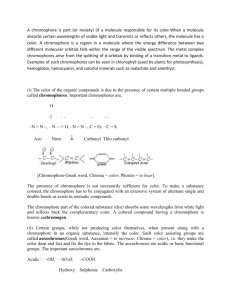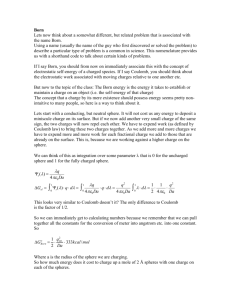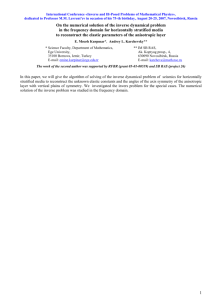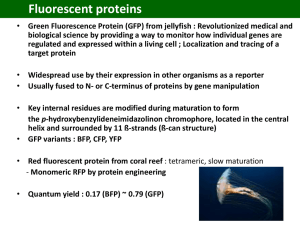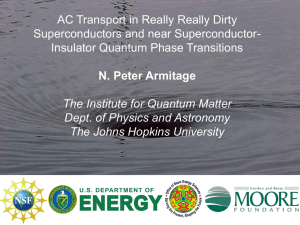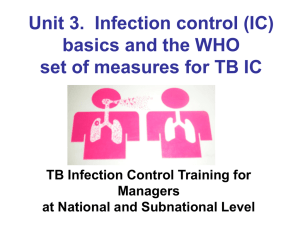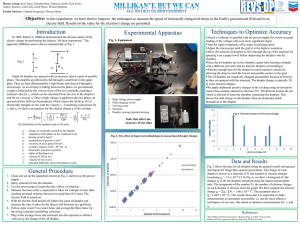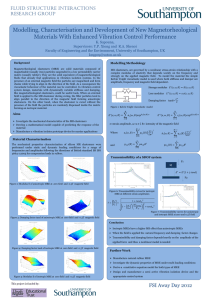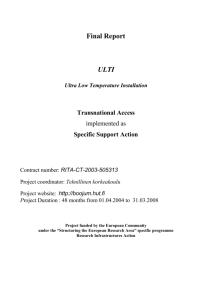Electronic spectroscopy in superfluid helium
advertisement
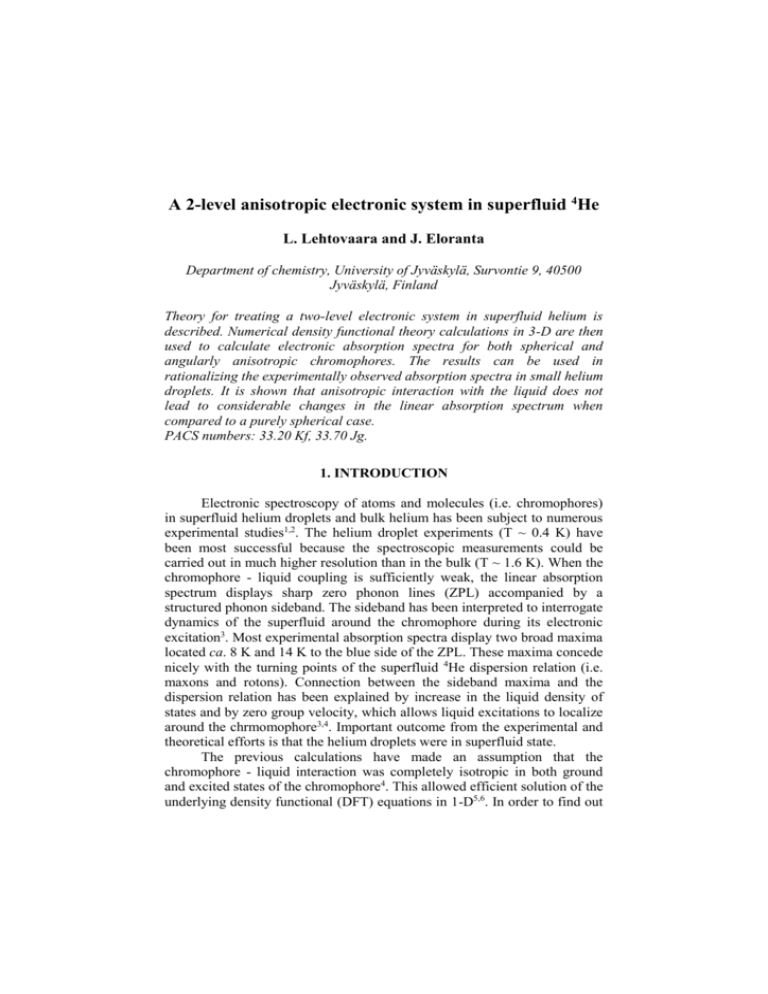
A 2-level anisotropic electronic system in superfluid 4He L. Lehtovaara and J. Eloranta Department of chemistry, University of Jyväskylä, Survontie 9, 40500 Jyväskylä, Finland Theory for treating a two-level electronic system in superfluid helium is described. Numerical density functional theory calculations in 3-D are then used to calculate electronic absorption spectra for both spherical and angularly anisotropic chromophores. The results can be used in rationalizing the experimentally observed absorption spectra in small helium droplets. It is shown that anisotropic interaction with the liquid does not lead to considerable changes in the linear absorption spectrum when compared to a purely spherical case. PACS numbers: 33.20 Kf, 33.70 Jg. 1. INTRODUCTION Electronic spectroscopy of atoms and molecules (i.e. chromophores) in superfluid helium droplets and bulk helium has been subject to numerous experimental studies1,2. The helium droplet experiments (T ~ 0.4 K) have been most successful because the spectroscopic measurements could be carried out in much higher resolution than in the bulk (T ~ 1.6 K). When the chromophore - liquid coupling is sufficiently weak, the linear absorption spectrum displays sharp zero phonon lines (ZPL) accompanied by a structured phonon sideband. The sideband has been interpreted to interrogate dynamics of the superfluid around the chromophore during its electronic excitation3. Most experimental absorption spectra display two broad maxima located ca. 8 K and 14 K to the blue side of the ZPL. These maxima concede nicely with the turning points of the superfluid 4He dispersion relation (i.e. maxons and rotons). Connection between the sideband maxima and the dispersion relation has been explained by increase in the liquid density of states and by zero group velocity, which allows liquid excitations to localize around the chrmomophore3,4. Important outcome from the experimental and theoretical efforts is that the helium droplets were in superfluid state. The previous calculations have made an assumption that the chromophore - liquid interaction was completely isotropic in both ground and excited states of the chromophore4. This allowed efficient solution of the underlying density functional (DFT) equations in 1-D5,6. In order to find out L. Lehtovaara and J. Eloranta the effect of an anisotropic interaction, the density functional equations must be solved numerically in 3-D7,8. However, from the practical point of view, it is clear that only small helium droplets can be considered in 3-D. For example, in large droplets and bulk, the liquid breathing mode around the chromophore occurs in the time scale of tens of ps and dissipates by emitting long wavelength phonons (~ 100 Å)9. In order to obtain the correct description for the liquid, the applied numerical grid must clearly have greater spatial extent than these phonons. The memory storage requirements will quickly exceed the limits on any modern supercomputer. This fact seriously limits the applicability of evenly spaced 3-D grid approaches in solving the DFT equations for superfluid 4He. Another issue, when calculating the electronic spectra of a two-level system in the superfluid bath, is connected to the time evolution of the system. In many cases the system must be propagated for tens of ps in order to obtain high quality spectra from the numerical simulations. This tends to lead to excessive computational burden even when efficient parallel computers are used8. In this paper we consider a hypothetical atomic chromophore in superfluid 4He, which has two electronic states. The ground state is taken to be anisotropic with both bound and repulsive parts (i.e. atomic 2P entity) and the degree of anisotropy can be adjusted by a single parameter. The excited state is purely spherical and repulsive (i.e. atomic 2S). Dynamics of the system is obtained by switching the chromophore - liquid potential from the ground to the excited state and following time evolution of the superfluid. The time dependent liquid density can then be transformed to the linear absorption spectrum for the chromophore4. The effect of anisotropy on both dynamics and spectroscopy will be studied in this work. 2. THEORY Time dependent density functional theory for superfluid 4He and the numerical implementation has been described previously5,7,8. The static liquid structure around ground state chromophore was obtained by the wellknown imaginary time-step method, where we estimated the single particle energy from the following expression: 3 1 h ( R, )d R (1) E( ) ln 2 N where is the simulation imaginary time step and N is the number of atoms in the droplet. The chromophore is assumed to consist of an energetically well-separated two-level system, which is subject to adiabatically evolving liquid bath. Essentially, the liquid bath introduces a time-dependent potential, which modulates energy levels of the chromophore. By denoting A 2-level anisotropic electronic system in superfluid 4He the time dependent electronic Hamiltonian, which includes the bath interaction, by H0, the 0th and 1st order electronic wave functions become: t (0) (t) e i H 0 (t' )dt' h 0 (0) (0) (2) 1 (0) (t) e H1 (t') (t')dt' ih 0 In this expression H1 corresponds to the time dependent field - matter term due to incident light. More specifically, H1 = .(,t), where is the transition dipole moment and is the electric field. These solutions can be further used in calculating the time dependent first order polarization P(1)(t): t (1) t i H (t'' )dt'' h t ' 0 P (1) ( ,t) (0) (t) (1) (t) c.c. i t i t i t' H 0 (t '')dt '' H 0 (t '')dt '' H 0 (t '')dt '' i h h h (0) (0) | e 0 e t ' e 0 | (0) (0) ( ,t ')dt ' (3) h0 t t t c.c. i e i Eext (t '')dt ''i t ' h t' dt ' c.c. [in units of Cm] 0 where H0 was taken only to contain the chromophore - liquid energy Eext because the electronic part is purely a constant offset in resonance energy. This term can be obtained from the instantaneous liquid density by: e g Eext (t) He (R,t)Ve (R)d 3 R He (R)Vg (R)d 3 R (4) where Ve and Vg are the chromophore - He pair potentials. He(R, t) was first initialized to the ground state density at t = 0 and then evolved according to the TDDFT equations employing the excited state potential. Given in (3), the linear absorption spectrum can be obtained by Fourier transforming P(1)(, t) to P(1)(, ') and setting = '.10 The obtained expression essentially Fourier transforms (4) and yields possible overtones for frequencies with decreasing intensities. In this work we employ two different practical methods for evaluating (3): (I) direct Fourier transform of (4) and (II) more accurate, but still approximate form of (3):4,10 t 2 I( ) F(g(t)) , where g(t) exp i Eext (t ') / hdt ' (5) 0 In this work the pair potential in (4) for anisotropic case was taken to be in the following form: e L. Lehtovaara and J. Eloranta Vx,g y (R) De 1 e ( R Re ) e Vx, y, z (R) De e2 ( R Re ) 1 2 Vzg (R) De e2 ( R Re ) (6) where the Morse potential parameters for the ground are De = 25 K, = 1.5 Å1, and Re = 3.5 Å. For isotropic case the ground state potential was spherically averaged. The applied potentials are plotted in figure 1. Fig. 1. Ground state potentials (solid) along with the ground state liquid solutions (dashed) are shown. Left: isotropic, middle: anisotropic with binding in xy-plane, right: anisotropic case with repulsion in z-direction. In this work we have modeled a small droplet with N = 200. Typical time steps used in the calculations were ~ 10 fs resulting in total simulation time ~ 150 ps. The spatial grid consisted of 256 256 256 points with a step of 0.21 Å. Due to limited amount of available memory, we were forced to use absorbing boundaries, which essentially prevented excess liquid from entering the outer periodic boundary6. Practical calculations were carried out using an IBM eServer Cluster 1600 parallel computer with 8 processors. 3. RESULTS AND DISCUSSION The minimum energy solutions for the liquid around the ground state chromophore are shown in figure 1. The obtained solutions had single particle energies of ~ 5.2 K / atom for both isotropic and anisotropic cases. The overall maximum liquid density occurring in the ground state solutions was 0.064 Å-3 (ca. 3 0 in the bulk). With the given initial solution, dynamics of the system was followed after suddenly switching the potential to correspond to the excited state (i.e. Ve in (6)). In the case of isotropic ground state chromophore - He potential, the most prominent motion is an Swave that oscillates between the chromophore and the droplet surface. This mode has a frequency that is essentially dictated by the distance between the chromophore and the droplet boundary. In the present case the breathing A 2-level anisotropic electronic system in superfluid 4He frequency is 3.3 K, which is roughly consistent with the previous model 4. Part of the liquid was detached from the droplet surface after the first and strongest excitation hit the surface. However, it was not possible to make proper analysis of the evaporation process because the detached liquid was almost instantly absorbed by the boundaries. When the initial chromophore He potential was anisotropic, only the initial phase of the dynamics was distinctly different from the isotropic case. The void areas in the ground state began to fill rapidly with liquid. This essentially made the liquid distribution more spherical. After spherical geometry was reached the dynamics proceeded closely in the same way as in the isotropic case. Snapshots of the liquid density and momentum distribution for anisotropic case are shown in figure 2. Fig. 2. Liquid density evolution (contours) along with liquid momentum (v; arrows) for the anisotropic case is shown (left at 100 fs, right at 1000 fs). The obtained linear absorption spectra for the two cases were identical and are shown in figure 3. They appear identical because the initial phase of the dynamics has negligible contribution to the overall spectrum. The spectrum consists of sharp ZPL and one strong line located at 3.3 K that corresponds to oscillation of the S-wave. However, as shown previously, this spectral feature is subject to serious inhomogeneous broadening and should not be observed experimentally when the chromophore has a shallow trapping potential within the droplet4. It may be possible to observe this line for ionic chromophores, which, on the contrary, have very steep trapping potentials within the droplet. Thus they have a well-defined position at the droplet center at finite temperatures. In this case the droplet size should also be chosen to be small in order to generate steep enough trapping potential. We also note that only one line is observed in the present spectrum because of the small droplet radius and cut-off energy leading to liquid evaporation. The cut-off energy should be related to the single particle binding energy in the excited state. In the present case of small droplets, we did not observe any analogs of the maxon-roton bands. Proper localization of these L. Lehtovaara and J. Eloranta excitations at the chromophore is seriously disturbed by the closely lying droplet boundary region. Finally, we show a comparison between the previously applied method for calculating the absorption spectrum (i.e. method (I)) and the new formula (II). Their difference is demonstrated in figure 3. The results are essentially same in both cases except for band intensities. The method (I) tends to produce larger intensities at high energies as compared to (II), especially if components would exist above 10 K. By accident this is actually an advantage in (I) because many experiments have used high laser intensities, which led to power saturation of the ZPL and enhancement of the high-energy bands3. Fig. 3. Linear absorption spectrum originating from the chromophore ground to excited state transition. The right panel shows direct Fourier transform of (4) with ZPL component removed and the left panel new the expression (5). REFERENCES 1. F. Stienkemeier and A. F. Vilesov, J. Chem. Phys. 115, 10119 (2001). 2. Q. Hui and M. Takami, J. Low Temp. Phys. 119, 393 (2000). 3. M. Hartmann, F. Mielke, J. P. Toennies, A. F. Vilesov, and G. Benedek, Phys. Rev. Lett. 76, 4560 (1996). 4. J. Eloranta, H. Ye. Seferyan, and V. A. Apkarian, Submitted to Chem. Phys. Lett. (2004). 5. F. Dalfovo, A. Lastri, L. Pricaupenko, S. Stringari, and J. Treiner, Phys. Rev. B 52, 1193 (1995). 6. J. Eloranta and V. A. Apkarian, J. Chem. Phys. 117, 10139 (2002). 7. L. Giacomazzi, F. Toigo, and F. Ancilotto, Phys. Rev. B 67, 104501 (2003). 8. L. Lehtovaara, T. Kiljunen, and J. Eloranta, J. Comp. Phys. 194, 78 (2004). 9. A. V. Benderskii, J. Eloranta, R. Zadoyan, and V. A. Apkarian, J. Chem. Phys. 117, 1201 (2002). 10. D. J. Tannor, Quantum mechanics: a time dependent perspective (University science press, Sausalito 2004).
